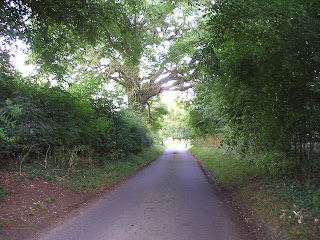The Story of Lorna Doone - just a myth?
Lorna Doone is the
tale of a young boy, John Ridd, whose father is killed by Scottish outlaws –
the Doones. Exiled to a remote part of Exmoor (which is in
England’s West Country and now a National Park), they rob travellers and local
farms. Living amongst them is the pretty
Lorna Doone, kidnapped by them as an infant.
John enters the forbidden Doone Valley by climbing a steep and difficult
waterfall, the ‘waterslide’, and meets Lorna for the first time. Some years later he rescues her and as they
marry Lorna is shot through the window of Oare church by the wicked Carver Doone. John pursues him and after a struggle Carver
perishes in a bog. Lorna recovers from
her wounds and so the story has a happy ending.
Oare Church
But is it true? The simple answer to the question is that the answer isn’t simple. When Richard Dodderidge Blackmore wrote his historic novel in the late 1800’s he mixed fact with fiction and local legend with the names of local people.
Because the precise location of the Doone Valley is
uncertain it is no longer described as such on maps, the Ordnance Survey now
describing the area more accurately as Doone Country. A rewarding walk can be taken along the whole
length of Badgworthy Water starting from Brendon Common by parking the car at
Brendon Two Gates. Here there are wide
views of both the open heather moorland and also the grass moor of the Royal
Forest ‘improved’ in the nineteenth century.
Badgworthy Water changes in character along its length from fast running rapids to
smoother, deeper pools.
Badgworthy Water
Oare Church
But is it true? The simple answer to the question is that the answer isn’t simple. When Richard Dodderidge Blackmore wrote his historic novel in the late 1800’s he mixed fact with fiction and local legend with the names of local people.
Blackmore placed the Doone stronghold beside Badgworthy
(pronounced ‘Badgery’) Water. There is a
deserted medieval village beside a tributary in Hoccombe Combe and it is very
probable that this is the site for the ruins were still visible in Blackmore’s
day. However the Waterslide is not found
there but in another side valley, Lank Combe. Nowhere as sheer as described it
is, however, an impressive sight with its three smooth slabs of rock especially
when the river is in spate. I like to
think that he also had in mind the waterslide at Watersmeet a
few miles further downstream which would be much more of a challenging climb.
The waterslide at Watersmeet
Badgworthy Water
The above walk is rugged and long but a more gentle approach
is from Malmsmead with its much photographed packhorse bridge and ford that also denotes the county border between Devon and Somerset.
Further along the lane nestles the village of Oare and the
church where Lorna and John wed. Inside
is a memorial to Blackmore, a smaller copy of the one in Exeter cathedral. A memorial can also be seen to the Snow
family who lived at Oare manor and also feature in Lorna Doone. It is recorded that as Blackmore didn’t write kindly
of the Snows he was afterwards much disliked by them. Other local characters also existed: Tom
Faggus, the highwayman was – in real life – from nearby North Molton and Ridd
is still a local surname.
Oare village and church nestle in a deep combe
Malmsmead where Badgworthy Water crosses the road
Is Lorna Doone a story
based on truth? That is for the reader
to decide, perhaps after visiting Mother Meldrum’s cave in the Valley of Rocks,
for both are mentioned in Blackmore’s book.
The Valley of Rocks%2B%2B%2Bcopyright.jpg)
%2B%2B%2Bcopyright.jpg)
%2B%2B%2Bcopyright.jpg)


%2B%2B%2Bcopyright.jpg)
%2B%2B%2Bcopyright.jpg)
%2B%2B%2Bcopyright.jpg)


Gorgeous photos!
ReplyDeleteThanks!
DeleteI am named after Lorna Doone ..my name is Lorna Lee Burrill Breton
ReplyDeleteRather a late response but thank you for your message. It's a lovely name.
Delete